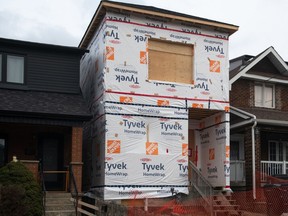Robert McLister: To snap potential buyers off the sidelines, builders are dangling the carrot of mortgage incentives

To snap potential buyers out of this trance, builders are dangling the carrot of mortgage incentives. Take Countrywide Homes, for example. It’s pitching three-year mortgage rates at just 2.34 per cent. That’s less than half the standard market rate.
“We have inventory that needs to be moved,” says Richard Mariani, sales and marketing manager for CountryWide Homes. “We’re essentially buying down the rate from the lender. And it helps. You get a lot of inquiries.”
I asked who the lender was, and he wouldn’t tell me. “The bank doesn’t want to put their name on it,” he said. “That way, there will be fewer questions from their other clients.”
Despite Countrywide’s red-hot financing promo, Mariani hasn’t seen any takers. “Purchasers are looking to negotiate one way or another, but most buyers have their own lender already, so if they want a sharper price, we’ll offer a better discount instead of the lower rate. I haven’t sold one with a mortgage yet.”
One reason might relate to mortgage qualifying. When a builder gives you an incentive, the lender typically deducts it from the lending value. In the case of an insured mortgage, the lender always deducts it.
The result is that you have to put more money down. For example, suppose you buy a $500,000 home with a five per cent down payment and a builder interest rate incentive worth $30,000. That $30,000 reduces the lending value to $470,000. Lenders will only give you a mortgage for up to 95 per cent of that, or $446,500. If no incentive was used, you could potentially qualify for a loan up to $475,000. (Default insurance fees are extra, and typically rolled into the mortgage.)
Effectively, by taking advantage of that tempting low rate, you more than double the required down payment. That’s why some borrowers nudge builders for a fatter discount on the purchase price instead.
You also have to read the fine print. Some builders place restrictions on the size of the mortgage a promo rate applies to. In Countrywide’s case, their max mortgage is $1 million, even though they sell many homes for north of $2 million.
By the way, it may take a while, but once rates drop enough to get more homebuyers off the couch and into builder sales centres, these incentives will start going by the wayside.
“It could take us two to three years before we get back to a hot market,” Mariani predicts. And if rates continue plummeting like they have since June, it could be sooner. “The shrewd buyer who’s been on the sideline is just watching and waiting.”
30-year insured amortizations are back
Default-insured first-time buyers putting down less than 20 per cent can now get a 30-year amortization if they buy a new construction home. This is the government’s play to incentivize builders to build and give buyers a break on their monthly payments.
“I think it will help (spur construction),” says Mariani. It’s one reason why “we’re starting to have more product under $1 million,” he adds.
Unfortunately, due to out-of-date default insurance rules that limit default insurance to homes priced at $999,999 or less, it won’t incentivize much single-family home building in large markets.
In 2021, the Liberal government proposed to “increase the insured mortgage cut-off from $1 million to $1.25 million, and index this to inflation, to better reflect today’s home prices since this threshold was last changed years ago.” Three years later, and it’s still a whole lot of crickets.
The rates displayed below are updated by the end of each day and are sourced from the Canadian Mortgage Rate Survey produced by MortgageLogic.news. Postmedia and Imaginative. Online Inc., parent of MortgageLogic.news, are compensated by certain mortgage providers when you click on their links in the charts.